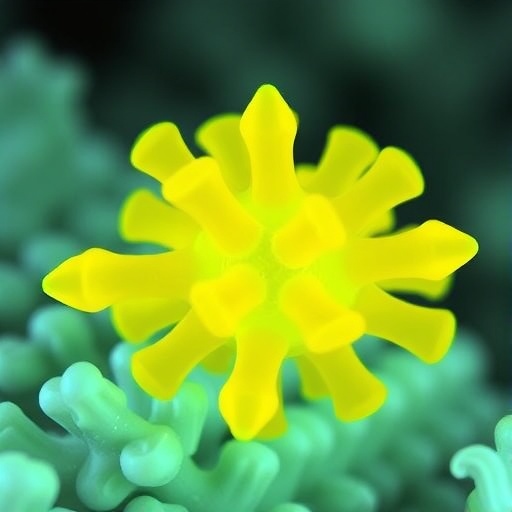In a groundbreaking advancement poised to redefine the landscape of structural biology, scientists at the VIB-VUB Center for Structural Biology have unveiled an innovative microfluidic technology that dramatically reduces the material requirements for high-resolution cryogenic electron microscopy (cryo-EM). This pioneering method, detailed in a recent publication in Nature Methods, introduces the MISO (microfluidic protein isolation) platform, a sophisticated integration of protein purification and cryo-EM grid preparation. This workflow innovation stands to cut the sample amounts needed by an astonishing factor of 100 to 1,000 compared to existing protocols, addressing one of the most significant bottlenecks in structural analysis of biomolecules.
Cryo-EM has cemented itself as an indispensable technique for visualizing the architecture of biological macromolecules at near-atomic resolution, revealing intricate structural details critical to understanding molecular function. However, a persistent challenge has been the demanding sample requirements — conventional approaches necessitate the generation and purification of large volumes of proteins, many of which are discarded before only minuscule quantities finally reach the electron microscope. This inefficiency not only consumes valuable time and resources but also limits studies on rare or difficult-to-produce proteins.
The MISO platform tackles this problem head-on by miniaturizing the purification steps and consolidating them directly on the microfluidic chip. This eliminates the need for batch-scale protein production, instead enabling direct isolation and preparation from very small input biomass. Remarkably, MISO can take crude cell lysates through a seamless purification process and deposit purified protein samples onto cryo-EM grids in a matter of hours, compressing what typically takes days or weeks into a single day. This rapid, streamlined workflow not only expedites data acquisition but significantly expands the range of biological materials accessible to cryo-EM analysis.
Professor Rouslan Efremov, the senior author of the study, emphasizes the transformative nature of this development: “MISO fundamentally changes what is possible in structural biology. It empowers researchers to transition from raw biological material – down to a single cell colony – to a detailed near-atomic structure within the same day, using only a fraction of the protein traditionally required.” This statement underscores the profound implications for fields ranging from fundamental biochemistry to drug discovery, where rapid, resource-efficient structural determination can accelerate understanding and therapeutic innovation.
The robustness of the MISO system has been demonstrated across diverse protein classes. The team successfully resolved high-fidelity cryo-EM structures for both soluble enzymes and membrane proteins. One landmark achievement involved the purification and structural determination of β-galactosidase starting from the biomass derived from a single Escherichia coli colony. Equally impressive, the proton-activated chloride channel TMEM206, a membrane protein, was characterized using material equivalent to only half of a single mammalian cell culture dish, illustrating the method’s extraordinary sensitivity and efficiency.
Importantly, MISO’s utility extends beyond mere structural elucidation; it holds promise as a powerful discovery tool in proteomics and membrane protein biology. The researchers notably identified an unknown membrane protein directly from the cryo-EM density map, purified through the MISO workflow, showcasing the platform’s potential to reveal low-abundance or previously unstudied macromolecular complexes without exhaustive sample preparation. Such capability could revolutionize the characterization of elusive biomolecules, accelerating the pace of discovery in molecular and cellular biology.
Dr. Gangadhar Eluru, the study’s first author, highlights the accessibility benefits of this innovation: “This represents a major step toward making cryo-EM more accessible and efficient. Frequently, the primary challenge researchers face is not the imaging itself but procuring sufficient, high-quality protein material. MISO directly addresses this bottleneck.” With structural biology increasingly intersecting with translational science, the ability to work with minimal biological input broadens cryo-EM’s applicability to rare or precious samples such as primary cells, organoids, or clinical biopsies.
The technical core of MISO leverages advances in microfluidic engineering to integrate affinity purification steps on-chip, followed by controlled deposition of protein samples onto EM grids. This meticulous orchestration ensures protein integrity and homogeneity, critical parameters for accurate single-particle analysis. The microfluidic environment also minimizes sample loss and contamination risk, enhancing reproducibility and consistency.
Looking forward, the VIB-VUB team envisions further refinements and miniaturization of the MISO platform. Such developments aim to push the boundaries of cryo-EM into realms currently unattainable — such as routine structural determination from individual cells or small organoids, thus opening new vistas in structural cell biology and personalized medicine. The potential to capture molecular snapshots from biologically relevant contexts promises to deepen our grasp of health and disease at an unprecedented scale and detail.
This integration of microfluidics with cryo-EM crystallizes years of innovation in structural biology and bioengineering into a single, elegant workflow. By streamlining and scaling down protein isolation and grid preparation, MISO not only accelerates scientific throughput but democratizes access to cutting-edge structural tools, empowering laboratories worldwide to probe the molecular underpinnings of life with unmatched precision and efficiency.
In conclusion, the MISO platform represents a leap forward in cryo-EM technology, overcoming critical limitations related to sample quantity and preparation time. Through combining microfluidic protein isolation with direct grid preparation, it transforms the paradigms of protein structural analysis and sets a new standard for what is achievable with limited biological material. As this technology gains adoption, it is poised to catalyze a new era in molecular and structural biology, revolutionizing research into the fundamental mechanisms of the cell and accelerating discovery across the life sciences.
Subject of Research: Not applicable
Article Title: MISO: microfluidic protein isolation enables single-particle cryo-EM structure determination from a single cell colony
News Publication Date: 13-Nov-2025
Web References:
10.1038/s41592-025-02894-x
Keywords: Neuroscience, Biochemistry, Biophysics, Microbiology, Molecular biology




